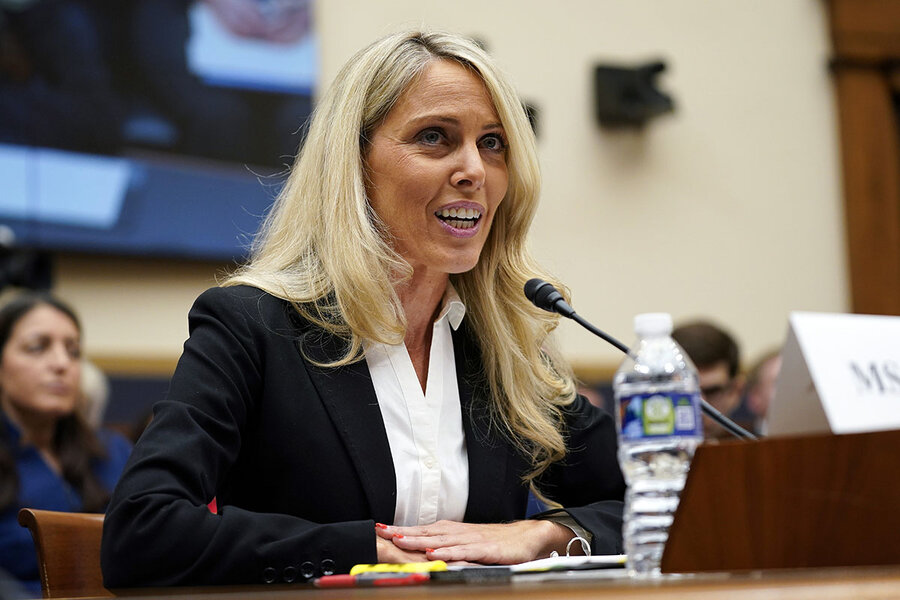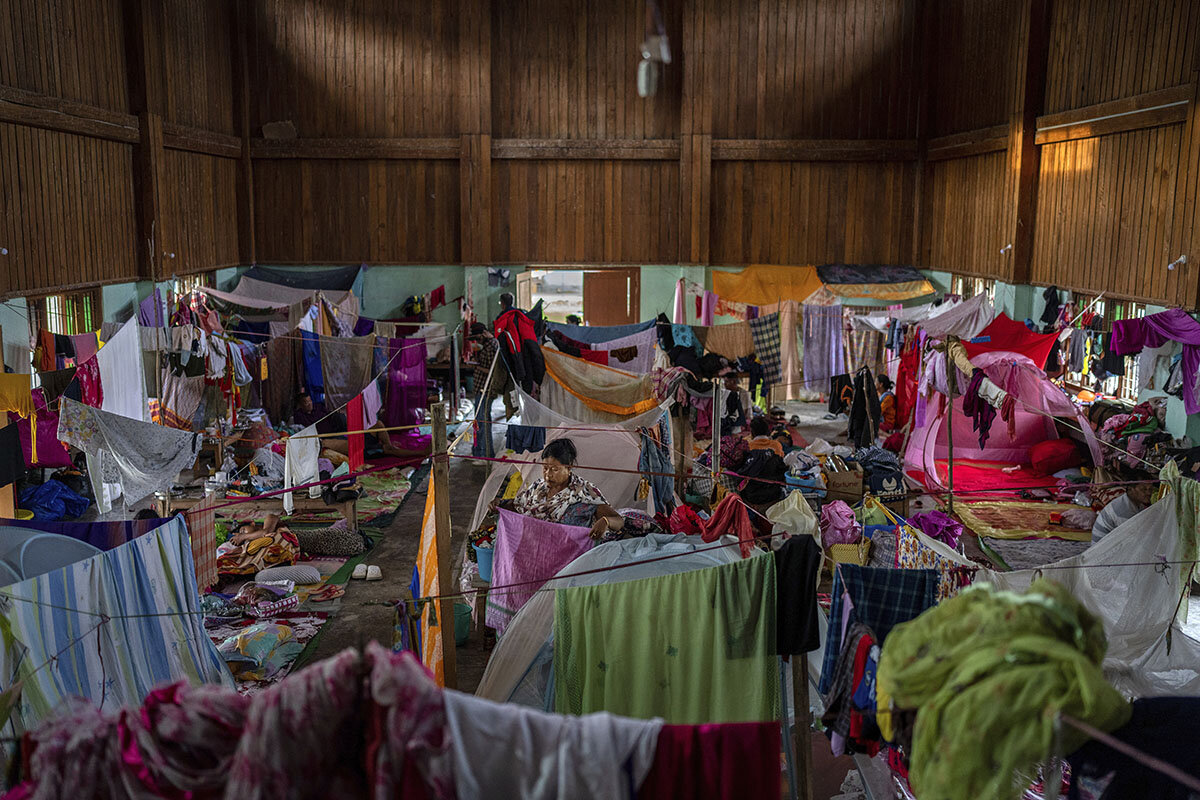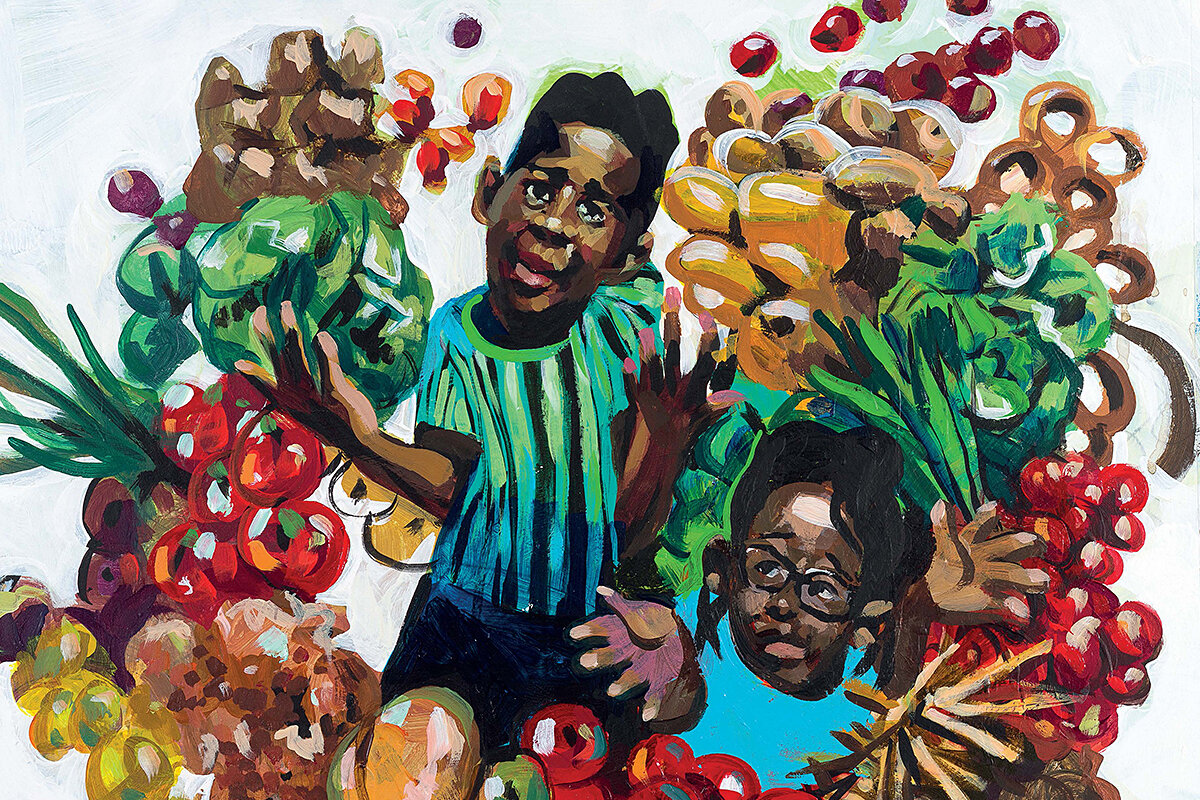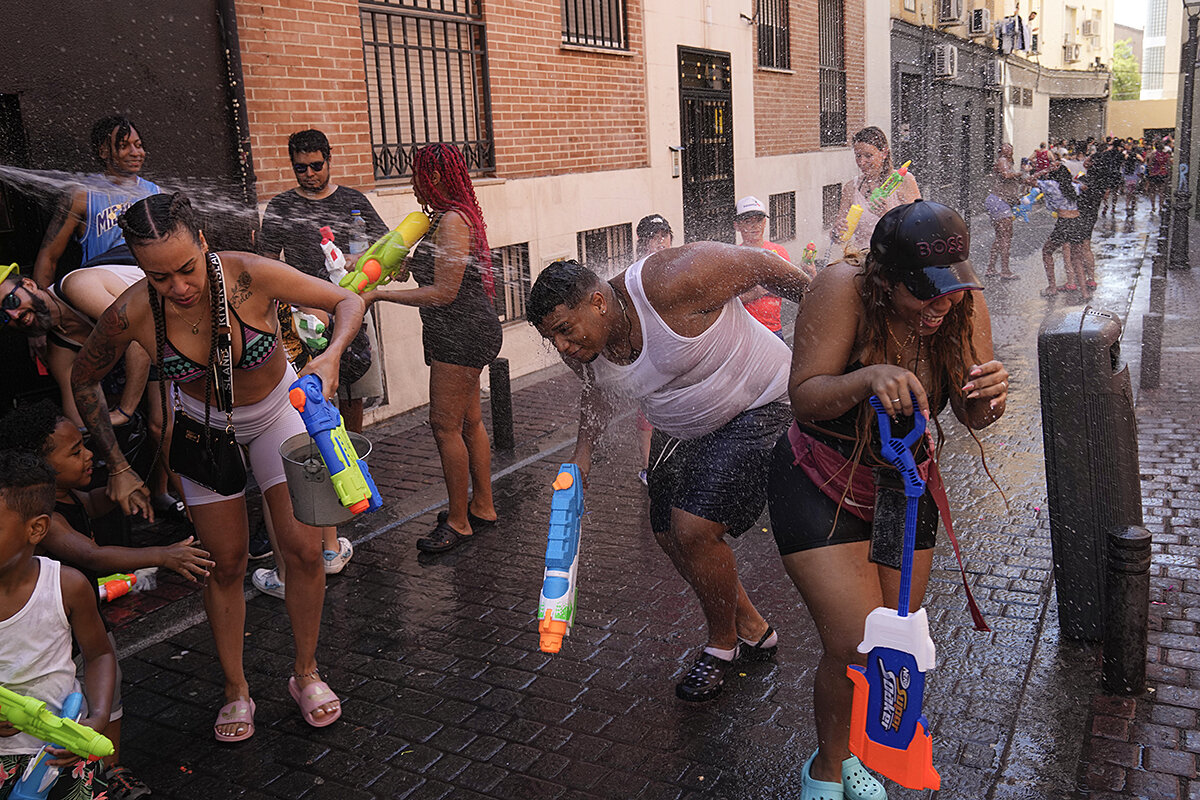- Quick Read
- Deep Read ( 6 Min. )
Monitor Daily Podcast
- Follow us:
- Apple Podcasts
- Spotify
- RSS Feed
- Download
TODAY’S INTRO
When a 1,100-page document isn’t enough
 Ira Porter
Ira Porter
Last week, New Hampshire radio host Arnie Arnesen asked me to join her show to talk about a recent story I wrote on reparations. The story was about California’s consideration of being the first U.S. state to issue reparations. Check it out here when you get a chance.
Ms. Arnesen asked me if working on the story taught me anything new about California, which made me reflect. I had learned that California was admitted to the union as a free state, but white slave owners flocking to the gold rush brought enslaved people with them, moving the evil practice west. I had learned that California enacted its own fugitive slave act, that the Ku Klux Klan terrorized people in the state during Jim Crow, that Black San Francisco and Los Angeles neighborhoods were gutted by government land seizures that shattered families and businesses.
Much of this was in a 1,100-page document put together by a task force and full of recommendations to address discrepancies in housing, education, mass incarceration, health care, and economics. Task force members I spoke with stressed a crucial point: The source materials that helped them make their recommendations should be made available to the public. They are a trove of information.
Initial public reaction to the task force’s recommendations included widespread concern that reparations would be too expensive. Ms. Arnesen’s question made me realize why democratizing the information is so important. It has the capacity to soften hearts. Regardless of whether reparations come to fruition or not, if truth is being served, we should all eat the dish.
Share this article
Link copied.

Help fund Monitor journalism for $11/ month
Already a subscriber? Login

Monitor journalism changes lives because we open that too-small box that most people think they live in. We believe news can and should expand a sense of identity and possibility beyond narrow conventional expectations.
Our work isn't possible without your support.
Once seen as ‘conservative,’ FBI faces GOP attacks
Trust in the FBI has been plummeting among Republicans during the Trump era, as voters increasingly see institutions – including law enforcement – as being weaponized for political purposes.

-
Patrik Jonsson Staff writer
For decades, the FBI was socially and politically conservative. Agents – virtually all men, wearing dark suits, white shirts, and ties – chased communists and spied on civil rights leaders. Directors were mostly Republicans or on good terms with the GOP.
Today, the FBI’s world has been flipped upside down. Many GOP lawmakers are attacking the bureau as, in their view, a tool of Democrats. They criticize its investigation into former President Donald Trump and Russia, its efforts to rein in right-wing extremist groups, and its electronic surveillance mistakes, among other things.
Over the past few years, the FBI’s reputation has cratered among Republicans. According to Pew Research Center data, 53% of GOP voters now view the bureau unfavorably.
The FBI has already instituted some reforms in response to the criticism it has received. But some say more needs to be done to rebuild public trust.
“It’s just very dangerous for a government or country to have people believe that law enforcement is fundamentally political, and that one party is going to be advantaged and [the] other disadvantaged,” says Stewart Baker, former general counsel of the National Security Agency. “It’s something to be avoided at all costs.”
Once seen as ‘conservative,’ FBI faces GOP attacks

For decades under J. Edgar Hoover, the FBI was socially and politically conservative. Agents – virtually all men, many of them Southerners from Mr. Hoover’s alma mater, George Washington University – wore dark suits, white shirts, and ties. At work, coats were not to be removed.
The bureau loosened up over the years. But it retained its buttoned-down aura. Agents chased communists and spied on civil rights leaders. Directors were not all Republicans, but they mostly remained on good terms with the GOP.
Today, the FBI’s world has been flipped upside down. Seven years into the Republican Party’s era of Donald Trump, many GOP lawmakers are attacking the bureau as, in their view, a tool of Democrats. Where once conservatives defended the FBI as the embodiment of American law and order, they now criticize its investigation into Mr. Trump and Russia, its efforts to rein in right-wing extremist groups, and its electronic surveillance mistakes, among other things.
Some House Republicans have gone so far as to call for the FBI’s defunding. At a contentious House hearing last week, multiple GOP lawmakers peppered FBI Director Christopher Wray with questions about whether bureau agents or sources were present at the U.S. Capitol on Jan. 6, apparently reflecting a theory, for which there is little hard evidence, that the FBI helped stir up the insurrection.
“I’m sure a lot of Democrats will say, ‘That’s just a conspiracy theory, and it’s wrong, so we can dismiss it,’” says Stewart Baker, the former general counsel of the National Security Agency. “But you can’t dismiss a large portion of the body politic that believes those things about your law enforcement and national security agencies.”
Drop in trust among Republicans
For much of its history, the FBI has been one of the nation’s most popular government agencies. Self-promotion has bolstered this: Ghost-written books published under Mr. Hoover’s name were big bestsellers in the 1950s. An authorized TV series based on bureau case files and starring actor Efrem Zimbalist Jr., “The F.B.I.,” aimed to draw in younger viewers in the mid-1960s.
The FBI’s status was dented by revelations in the 1970s about abusive programs such as COINTELPRO, which aimed to directly disrupt and divert perceived leftist organizations, including civil rights groups and anti-war protestors. But over decades, the agency regained voter esteem. As recently as 2010, 71% of Republicans and Republican-leaners and 68% of Democrats and Democratic-leaners had a favorable opinion of the FBI, according to Pew Research Center data. Today, a slight majority of all voters still say they have a positive view of the bureau, according to Pew.
But in the past few years, the FBI’s reputation has cratered among Republicans. The most recent Pew numbers show that 53% of GOP voters now view the bureau unfavorably. Other polls show similar results.
At the heart of the decline are perceptions that the bureau has unfairly targeted Mr. Trump. Half of all GOP respondents to a Pennsylvania State University poll taken last November agreed with the statement “Many FBI agents do not enforce the law fairly, because they are biased against former President Trump and his agenda.”
When GOP lawmakers berate FBI officials at hearings for perceived malfeasance, they are saying things many of their constituents already believe.

Some former FBI agents also agree with the negative assessments.
“Over the course of my 12-plus years ... the FBI’s trajectory has transformed,” said Nicole Parker, a former special agent, at a House Judiciary subcommittee hearing on Feb. 9. “The FBI became politically weaponized, starting from the top in Washington and trickling down to the field offices.”
Ms. Parker cited as evidence the May report by special counsel John Durham on the origins of the FBI investigation into allegations linking Mr. Trump to Russia. Mr. Durham was highly critical of the bureau’s handling of that case, saying agents had suffered from “confirmation bias” in which they discounted exculpatory information, rushed to open a full investigation instead of a preliminary probe, and made serious errors when applying for a wiretap on former Trump campaign aide Carter Page.
But Mr. Durham’s report did not uncover the “crime of the century,” as Mr. Trump had insisted it would. It did not refute the underlying findings of special counsel Robert Mueller’s investigation into Russian meddling in the 2016 election, which revealed multiple contacts between Trump campaign aides and the Russians. Mr. Durham charged no major figures with any crimes. The two minor criminal cases he did bring both ended in acquittals.
Another former agent called the criticism of the FBI’s handling of the Trump affair a “narrative that’s being sold” by a “handful” of former agents.
“But it’s not true,” said the former agent, who did not want to be quoted by name since their employer had not given them permission to speak to the press.
Charges of politicization
FBI Director Wray’s appearance last Wednesday before the Republican-controlled House Judiciary Committee exemplified the current tensions between the GOP and the bureau.
Republican lawmakers peppered Mr. Wray with questions about whether he was protecting President Joe Biden and his son Hunter Biden from prosecution on serious charges related to the younger Mr. Biden’s foreign business dealings. Mr. Wray said emphatically that he was not.
Some Republicans complained about the FBI’s part in monitoring disinformation and true threats on social media and wondered whether the bureau had purposefully suppressed news reports about Hunter Biden’s laptop. Mr. Wray denied this.
In his opening statement, House Judiciary Chairman Jim Jordan referred to the FBI search of Mr. Trump’s Mar-a-Lago home for classified documents as a “raid.” Mr. Wray said that agents had probable cause to search the resort under a court-appointed warrant and tried not to attract undue attention to themselves.

Mr. Wray also flatly rejected the suggestions of some lawmakers that the FBI somehow stoked the Jan. 6 riot at the Capitol as “ludicrous.” The FBI chief, a registered Republican appointed to his post by Mr. Trump, also told one GOP questioner, “The idea that I’m biased against conservatives seems somewhat insane to me, given my own personal background.”
The bureau and Mr. Wray were in a tough spot in that hearing, says former agent Michael Clark, who specialized in white-collar corruption cases during a 23-year career with the bureau.
Members of Congress certainly have a right to do what they feel they need to do, says Mr. Clark, now a professor at the University of New Haven in West Haven, Connecticut. But when they start asking the FBI chief about current investigations – such as the Hunter Biden case – it puts him in an impossible situation, he says, because he is unable to talk about ongoing bureau work.
“A lot of politicians like to go on camera and get their soundbite by embarrassing people like Chris Wray, and make it sound like [the witness] is holding back,” Mr. Clark says.
That said, some agents in the field believed that in 2016 top bureau agents such as then-director James Comey gave the appearance of partisanship by the manner in which they took control of and handled politically-sensitive investigations, such as the case involving then-presidential candidate Hillary Rodham Clinton’s use of a private server for classified emails.
Mr. Comey broke bureau precedent by issuing a statement a few months prior to the election saying Mrs. Clinton would not be charged. Then, just days before the vote, he said publicly that the probe had been reopened. (It was eventually closed with no charges.)
“Most of the agents saw that as a dark period where [FBI leadership] played politics and played it poorly,” says Mr. Clark.
Going forward
The FBI has instituted some reforms in response to the criticism it has received in recent years. In 2019, Mr. Wray ordered a series of changes to FBI procedures for obtaining the type of wiretaps that targeted Mr. Page, the former Trump aide.
What else might be done to bolster GOP trust? One idea involves the appointment of a high-level civil liberties and privacy officer to investigate any credible claim of partisanship and then report publicly and to Congress on what they find.
Mr. Baker, the former NSA general counsel, says he has lobbied Washington leaders to create such a post.
“In the long run, it’s just very dangerous for a government or country to have people believe that law enforcement is fundamentally political, and that one party is going to be advantaged and [the] other disadvantaged in criminal law enforcement and national security – it’s something to be avoided at all costs,” he says.

Why Israel democracy protests have surged again
At a previous crescendo of Israeli protests over the controversial judicial reform plans, the government backed off. But talks at reaching a compromise collapsed. As a first bill moves toward passage, distrust runs deep, and protesters vow to resist.

- Quick Read
- Deep Read ( 6 Min. )
-
By Neri Zilber Contributor
The wall of noise at Israel’s Ben Gurion Airport was all-encompassing and relentless: thousands of demonstrators with drums and horns, chanting against the government’s renewed push to overhaul the country’s judicial system. The workday protest was part of a nationwide “day of disruption” last Tuesday opposing the government’s plans and targeting the nation’s ports and roads.
Polls show some 70% of the country is still opposed to the proposed judicial program.
Prime Minister Benjamin Netanyahu had been forced to back down from his original plan to pass a slew of laws earlier this year, announcing a pause in late March amid mass demonstrations, a general strike, and a growing movement by military reservists to refuse to serve.
Yet senior government officials say they are intent on passing a first bill early next week targeting the ability of the Supreme Court to review government decisions and appointments. And signs are accumulating that both camps, deeply distrustful of each other, are heading with renewed determination toward an unprecedented collision over the nation’s democratic character.
“They’re stealing our home, they’re destroying it,” says Arnon, an older protester at the airport wearing a T-shirt that says, simply, “Democracy.”
“It was good here before all this began,” Arnon says. “They need to halt and stop everything.”
Why Israel democracy protests have surged again
The wall of noise at Israel’s Ben Gurion Airport was all-encompassing and relentless: thousands of demonstrators with drums and horns, chanting against the government’s renewed push to overhaul the country’s judicial system.
“They’re stealing our home; they’re destroying it,” says Arnon, an older man draped in a blue-and-white Israeli flag and wearing a T-shirt that says, simply, “Democracy.”
The workday protest was part of a nationwide “day of disruption” last Tuesday opposing the government’s plans and targeting the nation’s ports and roads.
Along with escalating demonstrations and government ministers’ vows that they’re not backing off, signs are accumulating that both camps, deeply distrustful of each other, are heading with renewed determination toward an unprecedented collision over the nation’s democratic character.
Legal experts say the government’s proposed legislation would undermine the powers of the Supreme Court and hand unchecked power to the government.
At the airport, Arnon’s wife, Mira, says that the couple, both in their 80s and offering only their first names, had taken to the streets to make their voices heard, as they had for the previous 27 weeks of protests against the far-right government’s plans.
“It wasn’t bad here; it was good here before all this began,” Arnon says. “They need to halt and stop everything.”
Amid previous widespread mass demonstrations, a general strike that paralyzed the country, and a growing movement by military reservists to refuse to serve, Prime Minister Benjamin Netanyahu had been forced to back down from his original plan to pass a slew of laws in parliament earlier this year, announcing a pause in late March.
Yet subsequent talks between the government and the opposition over a consensual judicial reform agenda collapsed last month.
Now senior government officials say they are intent on passing a first bill early next week targeting the ability of the Supreme Court to review government decisions and appointments.
A re-energized protest movement has drawn hundreds of thousands to the streets, and polls show some 70% of the country is still opposed to the government’s judicial program.

On an almost daily basis in recent weeks, demonstrators have shut down main highways across the country and protested outside the homes of government officials. The “day of disruption” last week went on for 17 straight hours, and another similar weekday action is planned for tomorrow.
This past weekend, at the weekly Saturday night demonstration in Tel Aviv, the nation’s largest, an estimated crowd of 150,000 people listened intently as Shikma Bressler, a research physicist and protest leader, paraphrased Winston Churchill. “We will never give in. ... We will fight everywhere,” she bellowed onstage. “History will record this time as the most important since the declaration of [Israeli] independence.”
“What will happen to girls?”
Nearby, taking a break from the din and the suffocating summertime humidity, were Yael and her 6-year-old daughter, Ella.
“In the middle, it’s important to eat ice cream,” Yael says as Ella tucks into a cup while still holding her yellow horn and keeping her red headphones on to diminish the noise.
“The situation has grown worse again, and I’m afraid of what will happen to girls in this country,” Yael says. The initial steps taken by the government – the most ultranationalist and religious in the country’s history – had already begun undermining gender equality, she says, and were “a testament to the overall trend” even before they succeeded in arrogating untold power for themselves. Among those steps: placing the committee for gender equality, which had been independent for years, under the purview of a government minister.
“It’s about her future,” Yael adds, looking down at her daughter. “We may not be able to raise kids here.”
Legal experts say the bill now being pushed through the Knesset, which would eliminate the court’s ability to strike down government decisions and civil servant appointments on the grounds of “extreme unreasonableness,” could have far-reaching consequences.
“It will definitely affect the rule of law, the integrity of the public sector, and will also threaten demonstrators who are currently protesting against the government’s policy – we may see much harsher treatment of demonstrators,” says Prof. Rivka Weill of the Harry Radzyner Law School at Reichman University.
Professor Weill calls the “removal of reasonableness” a “prelude” to the possible firing of the attorney general, the top legal official in the country. Other experts surmise that such a controversial move could usher in a new and more malleable appointment that would then suspend the ongoing corruption trial against Mr. Netanyahu.
For their part, government officials and supporters contend that such legislation is imperative in order to rein in what they deem an overly activist and liberal judiciary. Senior ministers have also made clear that the planned passage next week of this first bill will not be the end of the government’s radical power grab, as its detractors characterize it, but only the beginning.
“This will be a long and ongoing process,” Miki Zohar, a minister from Mr. Netanyahu’s Likud party known to reflect the premier’s thinking, said in an interview with a local news outlet. “The [judicial] reform is not just the ‘reasonableness clause,’ there are many other issues we want to fix.”
If anything, the growing protest movement has hardened government plans to push ahead, if only to show as a matter of principle that it is in charge and not the street.

Not even the swelling number of military reservists again announcing their intention to stop volunteering for service – including special forces, intelligence specialists, cyberwarriors, and air force personnel – has dissuaded the Netanyahu coalition, despite top generals warning of real damage to Israel’s war-fighting capabilities.
“It cannot be that there will be a group within the military that threatens the elected government: ‘If you do not do what we want, we will shut the switch on security,’” Mr. Netanyahu said at a Monday cabinet meeting. “No democratic country would accept such diktat; such diktat is the end of democracy.”
Dictatorship vs. democracy
Yet on the sidelines of the Tel Aviv demonstration Saturday, one of the key leaders of the reservist protest group, “Brothers in Arms,” preemptively dismisses such talk. Above him is a massive banner with the U.S. flag on one side, Mr. Netanyahu’s visage on the other, and a message – Persona Non Grata – referencing the Biden administration’s strong opposition to the judicial overhaul agenda.
“A.” – as he requests to be called – now in his mid-30s, was an officer in an elite covert unit responsible for Israel’s northern front with Lebanon.
“In my unit, during an emergency, 120 percent of us show up, we need to stop people at the gate because there’s just not enough equipment,” he says. “In Putin’s Russia, he has to arrest people at the border [and conscript them by force]. That’s the real difference between a dictatorship and a democracy.”
The reservists’ protest was meant to do two things, A. continues: indicate their unwillingness to serve in the army of a country that was no longer democratic and pressure the government to stop precisely that from happening.
“The fear here is definitely real. The people at the wheel [of this country now] don’t have many limits. ... They’re only guided by sectoral or personal interests,” A. says, highlighting the absurdity of a government effectively declaring war against its own best and brightest, its own military, and its own economy.
“The other week we blocked the entrance to the port in Haifa and I’m sitting in the middle of the road with my arms locked,” he continues. “The reservist to my right is a CEO responsible for 600 employees. To my left is another reservist and entrepreneur who raised millions of dollars for his start-up and pays a fortune in taxes to the state. And this is all happening in the middle of a weekday!”
A. says he’s not sure whether the reservists’ protest, and the overall protest, would ultimately win out; perhaps a general strike called by the large trade unions and local municipalities, similar to late March, would again tip the balance in their favor and force the government to again back down.
But he does promise one thing: “If this law does pass, we’ll escalate the protest.”

In India’s violence-wracked Manipur state, voices of hope
A relief camp for displaced children in India’s violence-wracked Manipur state shows the challenges of keeping hope alive amid crisis.

- Quick Read
- Deep Read ( 5 Min. )
Fighting between the Kuki tribal minority and the Meitei majority has fractured the state of Manipur in northeastern India. Since violence erupted in May, at least 140 people have been killed and 60,000 displaced as mobs burn through homes, shops, and churches. The Indian government sent troops to contain the violence, but peace remains elusive.
Yet on the ground, there are scenes of kindness as well as chaos.
On the outskirts of the capital, for example, volunteers have turned a schoolhouse into a haven for dozens of children who have been separated from their parents. It is one of around 350 makeshift relief camps that have emerged in recent months, and the volunteers – many are students themselves – work hard to provide more than the basic necessities. Through games, classes, and nightly singalongs, they hope to offer a refuge from the conflict.
Camp leaders say more people from the neighborhood are pitching in to help.
“When I learned about these kids, I could not hold back,” says Khomjam Samita, a mother of two young girls who works 12-hour days at the school. “I clean and cook every day here, along with other women. ... We are only trying to make it easy for them.”
In India’s violence-wracked Manipur state, voices of hope
Sunset brings anxiety for many in Manipur, a northeast Indian state on the brink of civil war. Night is when most of the fighting takes place, the calm shattered by sounds of gunshots and the sight of buildings set ablaze in the distance.
But on the outskirts of the capital, a Manipuri folk song emanates from a schoolhouse. Here, children who’ve been separated from their parents sing in unison every evening, bringing a modicum of joy and hope for the return of peace.
It is one of around 350 makeshift relief camps that have emerged since ethnic violence erupted in Manipur more than two months ago. At least 140 people have been killed and 60,000 displaced as angry mobs burn through homes, shops, and churches. Yet amid the chaos, there are helpers.
Around 20 young volunteers have turned this particular government school into a haven for dozens of children, ages 1 to 12, a few of whom are accompanied by a relative. The volunteers – many who are students themselves – work hard to provide more than the basic necessities. Through music, games, and other activities, they hope to offer displaced children a true refuge.
“Everyone was trying to help” when violence broke out, says Roosevelt, a volunteer who, like many in this part of India, goes by only one name. “We provide them a safe space, food, medicine, and, more importantly, what children need the most ... an escape from the ongoing war.”

A state divided
In May, long-standing tensions between the state’s Kuki tribal minority and the Meitei majority came to a head when the High Court ruling granted the latter “tribal status.” The order entitled Meiteis to economic and social benefits once reserved for the hill-dwelling minority groups, triggering pitched battles between the two communities; 60 people were killed in an initial two-day rampage, and violence has continued to spread.
Manipur has essentially been cleaved in two, with both sides forming their own militias to drive out members of the opposing community and maintain control of their territory. Some members of the vigilante groups patrol their areas wielding automatic and double-barrel rifles, while others keep vigil through sandbag-walled bunkers.

The central Indian government has deployed thousands of military and security forces to contain the violence, but peace remains elusive.
Meanwhile, Roosevelt and his friends have spent most of their time in the relief camp, caring for Meitei children whose parents are either being treated in hospitals or have returned to their villages to join armed vigilante groups. Volunteers start the day by making arrangements for the food, water, and other essentials, before engaging kids in games and music activities. They also do their best to provide academic lessons, with subjects varying based on the volunteer teachers’ expertise.
“The aim is to keep them busy, but also they should not miss on their studies,” says Roosevelt, a Ph.D. student researching Mathematics at Manipur University in Imphal when the fighting broke out. “We do not know how this conflict is going to last.”

More volunteers from the neighborhood have been joining Roosevelt’s group, including Khomjam Samita, a mother of two young girls. She comes every day at 8 a.m. and leaves after 8 p.m.
“When I learned about these kids, I could not hold back. I clean and cook every day here, along with other women,” she says. “I can imagine how difficult it must be for these kids to live without their parents. We are only trying to make it easy for them.”
One day at a time
While the young volunteers keep the camp’s children occupied, elders look after the babies and pray for peace.
Echantomni – who also goes by one name – paces the schoolhouse halls carrying her 15-month-old grandson in a shawl fastened to her back.
“His mother is ill, and that is why she is in a relief camp ... near a health facility while his father is protecting the village,” she says. “I have no choice but to stay here with him.”
The most difficult part is when the infants are hungry.
“We feed bottled milk, but he is not used to it,” laments Echantomni, who, like other caretakers, has been struggling to find baby food. “But I am happy. At least we are at a relatively safer place.”
Relief camps in Manipur largely depend on donations. But volunteers say it is becoming increasingly difficult to access necessities, with state-imposed curfews, internet blackouts, and ongoing violence disrupting the flow of supplies.

India’s main opposition leader, Rahul Gandhi, who recently visited the violence-hit areas, also highlighted poor conditions in the relief camps.
“I went to the camps, met people from all communities,” said Mr. Gandhi during a press conference. “One of the things that I want to say to the government is that the basic amenities in the camps need to be improved. The food needs to be improved; medicines need to be supplied.”
Echoing concerns shared by relief workers across Manipur, Roosevelt describes managing shortages of water and other essentials.
“There is no cooking gas available,” he says. “We collect firewood and use it, [but] even firewood is not easily available now, because of restrictions.”
There is little he can do to improve the state of supplies. Instead, the challenge has been ensuring these stressors don’t extinguish the sense of hope that volunteers have worked to preserve.
As another evening approaches, the children gather in a classroom. The walls are plastered with colorful drawings of their favorite anime character, a robotic cat named Doraemon, while a volunteer strums his guitar by the whiteboard. The children start to sing, and everyone’s face lights up – they’ve made it through another day.
(Editor’s note: The original version of this story's map contained a misspelling of Bangladesh.)


Difference-maker
Can a breadfruit revival bring food security?
Breadfruit, long a staple of Pacific island diets, is enjoying a resurgence – bolstering food security in part due to its potential resilience to climate change.

- Quick Read
- Deep Read ( 5 Min. )
In Hawaii these days, breadfruit seems to be everywhere.
The knobby green fruit appears on trendy restaurant menus. It is celebrated at festivals and studied by international scientists.
It is also growing on trees, in hardscrabble neighborhoods and on millionaire’s lawns, in middle-class backyards and on university campuses. That’s partly due to the work of Diane Ragone and others promoting the previously underutilized breadfruit tree. In recent years, Dr. Ragone has helped distribute some 10,000 or so specimens across the state.
But there is another, simple reason that she is seeing so much breadfruit: The plant is becoming popular again, bringing with it a return to an old approach to island food security.
Although breadfruit is not a great fit for industrial agriculture, it does provide local food resilience. With one mature breadfruit tree, a family can harvest nutrient-dense food for generations.
This is what Dr. Ragone realized decades ago, when she started her Ph.D. on the plant.
“I wanted to distribute so many breadfruit trees, to so many communities, that anyone who wanted breadfruit could have it,” she says. “If you had a church or community garden or anywhere that they could plant a breadfruit tree, we would give them a tree.”
Can a breadfruit revival bring food security?

When Diane Ragone travels around the Hawaiian Islands these days, it’s not hard for her to spot breadfruit.
It is there in the farmers markets, knobby green fruit the size of a softball. It’s listed on menus as an ingredient in soufflés and nachos, flours and pastas. It is celebrated at festivals and studied by international scientists; it is served at food banks.
It is also growing on trees.
Some of these trees are in the National Tropical Botanical Garden, grown from specimens that Dr. Ragone has collected from across the Pacific, tended by the staff of the Breadfruit Institute, an organization she helped create 20 years ago. But there are other breadfruit trees she can spot across the islands, in hardscrabble neighborhoods and on millionaire’s lawns, in middle-class backyards and on university campuses.
She can tell from their age and variety that many of these trees came from some of the 10,000 or so specimens that she and other groups have distributed across the state. But there is another, simple reason that she is seeing so much breadfruit: The plant, according to a number of researchers here, is becoming popular again, bringing with it a return to an old approach to island food security.
And that may be the most satisfying sign to Dr. Ragone that her decades of work have, literally, born fruit.
“It’s been profound, the change,” she says. “When I started working in the ’80s, there was some breadfruit here in Hawaii. Of course, there were some people and communities who grew breadfruit and like breadfruit and ate breadfruit. But overall, it was a really undergrown and underutilized plant.”
Breadfruit’s promise worldwide
The slow resurgence of breadfruit, a species that once served as a key food source across the Pacific but declined in use as local diets became more institutionalized, has big global implications, scientists say.
Last year, Northwestern University climate scientist Daniel Horton published a study showing that breadfruit, unlike other starchy staple crops, may be relatively unaffected by climate change. This is particularly important for the tropics, he says, where communities are facing the interconnected challenges of climate change and food insecurity.
“We see the emergence of climate change in the tropics earlier,” he says. “And because of this, we’re worried that crops that traditionally grow in that part of the world may ... not be able to grow in the kind of conditions that we’ll see in the future. And so that’s one of the beauties of breadfruit.”
Although the breadfruit is not a great fit for industrial agriculture, with its short shelf life and delicate harvest time, it does provide local food resilience. Dr. Horton’s partner on the study, Northwestern University and Chicago Botanic Garden breadfruit expert Nyree Zerega, says that with one mature breadfruit tree, a family can harvest nutrient-dense food for generations.
“It’s a perennial crop, a tree, so you plant it and it lives for years,” she says. “It doesn’t have as much of a carbon footprint [as other agricultural plants], and simultaneously it sequesters carbon. You can grow it mixed with other crops.”

For people who live on islands, who tend to rely heavily on food imports, this is a big deal. Once a tree matures, it provides 200 to 300 pounds of food every year, says Kento Nemoto, marketing manager of the Hawai‘i ‘Ulu Cooperative, a farmers organization named for the Hawaiian term for breadfruit. “In terms of food security, it’s an amazing tree,” he says.
This is what Dr. Ragone realized decades ago.
“She’s the pioneer of studying and researching breadfruit,” says Mr. Nemoto. “She’s basically the person who helped farmers and other organizations in the work of revitalizing breadfruit.”
That research started in the library archives at the University of Hawaii in the early 1980s. Dr. Ragone, then a master’s student in horticulture, was charged with writing a paper on a tropical plant and had decided to focus on breadfruit in Tahiti.
As she sifted through source material in the stacks, she kept coming across references to the plant in missionary accounts, agricultural reports, and more.
“I kept seeing this recurring theme,” she recalls. “It was such an important plant in the region, and had been for centuries and millennia, and it was at risk. Traditional varieties and knowledge about breadfruit was at risk. I was fascinated by that – it just called to me.”
Learning to grow
Inspired by the plant, she began a Ph.D. But there were stumbling blocks. Following the advice of professors (and much to the confusion of her local guides), she decided to collect stem cuttings of the breadfruit trees. But it turned out that stem cuttings are unlikely to survive; to propagate breadfruit, one needs cuttings from the tree’s root system. It was the first of what would be many challenges of finding, collecting, and then growing breadfruit.
During fieldwork on some 50 islands, she also recorded the ethnobotany of multiple communities. And then, in 2003 she helped found the Breadfruit Institute with the National Tropical Botanical Garden, and continued coordinating with colleagues throughout the tropics.
“We talk about food security for our nation,” she says, standing in the botanical garden’s agroforest – a layered, multispecies food garden that is a model of how Pacific Islanders would have traditionally grown breadfruit. “This is not just a U.S. problem; this is a global problem.”
Breadfruit, she believes, could be a solution – especially in response to the shift from nutrient-dense, local crops to a system based on long-distance transportation and fewer fresh foods. But distributing trees around the world isn’t necessarily easy.
After challenges with other approaches to propagation, in 2009 Dr. Ragone, the Breadfruit Institute, and partners in Canada launched an initiative to grow trees from germ plasm, or plant genetic material. Today, that effort is largely being carried out by California-based Tissue-Grown Corp. Through a partnership with the nonprofit Trees That Feed and other organizations, it has over the past three years grown and then distributed thousands of trees genetically sourced from Dr. Ragone’s breadfruits, mostly in Central America, the Caribbean, and Africa.
“Oh my goodness, everyone is interested in it,” says Karin Bolczyk, operations manager for Tissue-Grown. “And you feel like you are really making a difference. Every tree that gets into a backyard feeds a family for a century.”
That’s what Dr. Ragone sought from the start. “I wanted to distribute so many breadfruit trees, to so many communities, that anyone who wanted breadfruit could have it,” she says. “If you had a church or community garden or anywhere that they could plant a breadfruit tree, we would give them a tree.”

Books
Summer picture books: Parent-picked, kid-approved
Need something to do in the heat? Amid long summer breaks, reading gives families time to connect and keeps kids on track for school.

- Quick Read
- Deep Read ( 5 Min. )
With the kids home from school for the summer, these picture books are perfect for breaking up long days in the sun with some relaxing – and educational – family time. Here’s a taste of some of our favorites for an afternoon read.
“When You Can Swim,” written and illustrated by Jack Wong, transports young readers to a series of underwater worlds where adventures await. “When you can swim,” Wong writes, “you’ll conquer any fear.”
Growing up as an immigrant in Canada, Wong was never comfortable in the neighborhood pool. But when he learned to swim, the skill opened the door to the freedoms he explores in the book.
In “What Happened to You?” written by James Catchpole and illustrated by Karen George, little Joe is playing at the local playground when a group of children asks him why he has only one leg. The kids soon realize that they don’t need to know what happened to him to include Joe in their games.
Inspired by Catchpole’s experience growing up with a disability, the book tackles a serious subject with levity, heart, and understanding. The lighthearted story teaches children (and adults) how to be around people with disabilities and to look past outward appearances to what really matters.
Summer picture books: Parent-picked, kid-approved
When the long, lazy days of summer beckon, head to your local library for a pile of stories to plunge into with your little ones. These five will inspire, enlighten, entrance, and delight children and their grown-ups, preferably with a popsicle in hand and soft green grass underfoot.
Conquering fears
Deeply poetic and lyrical, “When You Can Swim” by Jack Wong is a meditative book that transports readers to a series of underwater worlds, a raft of adventures awaiting – when you can swim.
The prose is pure poetry, as are Wong’s soft, painterly illustrations of swirling eddies, melding colors, and dappled light. Wong created both by visiting his favorite swimming holes again and again, making sketches and taking notes and pictures. The result is a sensory treat.

“When you can swim, you’ll conquer any fear of tannin-soaked lakes pitch-dark from tree bark like oversteeped tea because that darkness will turn glittering gold when you gather it by the handful,” he writes.
The backstory here provides even more depth: Growing up as an immigrant in Canada, Wong was never comfortable in the neighborhood pool. His mother, afraid that he would drown, forbade him from swimming, which only compounded his anxieties. Later, when Wong took the plunge and learned to swim, the skill empowered him and opened the door to the freedoms and adventures he unveils in this gorgeous book.
I hope that when my kids read this immersive story, they appreciate being able to swim and value the buoyant freedom swimming offers. That’s something their parents never learned as children.
Treating others with kindness

Little Joe, the protagonist of “What Happened to You?” written by James Catchpole and illustrated by Karen George, is busy playing pirate at the local playground. A stream of kids begins asking him why he only has one leg. “Did it fall off?” asks one. “Was it a burglar?” “Was it a lion?” “Was it a thousand lions?” ask three more. When Joe moves away from them, upset, the kids realize they don’t need to know what happened to play together and have a jolly good time.
Inspired by author Catchpole’s own experience growing up with a disability, the book deftly tackles a serious subject with levity, heart, and understanding. The lighthearted story teaches children (and adults) how to be around people with disabilities and to look past outward appearances to what really matters.
Navigating setbacks
If only Alexander, of the 1972 classic “Alexander and the Terrible, Horrible, No Good, Very Bad Day,” had had Marc Colagiovanni’s latest book in his back pocket, things might have gone better for him. Colagiovanni’s “When Things Aren’t Going Right, Go Left” contains clever wordplay and whimsical illustrations by award-winning artist Peter H. Reynolds. The book teaches young ones how to navigate frustration and disappointment by managing fears, doubts, and worries, which are illustrated as concrete objects that the main character learns to shed. My 9-year-old noted that “when he left his worries, things were lighter on him,” literally.

In the story, the protagonist also confronts failure, falling flat on his back after diving into a pool – and gets back up and tries again. It’s a simple but powerful message for young readers.
My 7-year-old proclaimed this one of his favorite books because “it shows how worries, frustrations, and doubts look, and they look funny, not scary.” For him, seeing the emotions depicted disarmed them and made them manageable.
Direct and witty, this book is like the older sibling who knows how to give great advice: uplifting without feeling saccharine, helpful without being didactic.
Bridging cultures
Liberian torbogee soup versus homemade sausage pizza. Okra soup and rice versus spaghetti and meatballs. In “Sam and the Incredible African and American Food Fight” by Shannon Gibney, a nightly food feud is proxy for a culture war in Sam’s home, with his American mother in one corner of the kitchen, and his Liberian aunt and dad in the other, cooking double dinners every night. Trapped in the middle are Sam and his little sister, Connah, “who were half and half, stuck in-between.”

Breathtakingly bold and vibrant illustrations by award-winning fine artist Charly Palmer explode from each page, a visual feast of sorts that delighted and transfixed my kids – and had them requesting tasty new meals.
When the food-fight-meets-culture-contest reaches an impasse – Sam’s “tummy had only so much space, and both meals wouldn’t fit” – he finds a simple way to bridge the gap and bring his family together around the meal. A sweet and gentle lesson on reaching across differences and finding common ground, this book will leave you and your little ones smiling – and ravenous. (Thankfully, Gibney offers two recipes to start your own food adventure.)
Ripple effect
You can’t help but smile as you read “A Good Deed Can Grow” by Jennifer Chambliss Bertman, which practically pulsates with positivity and kindness. The endearing book beautifully illustrates – literally, with cheer-inducing pictures by Holly Hatam – the ripple effects of a single act of kindness, from picking up litter and sharing lemonade, to reading books to older adults at a senior citizens center and visiting a sick friend.

The book’s message is especially relevant in light of new research that shows kids and adults underestimate how seemingly small acts of kindness can have an outsize impact on receivers.
In other words, your smile really can change someone’s day.
If it all feels too hunky-dory, the book stays grounded with these lines on how to deal with problems, wise advice for kids and their grown-ups alike: “Sometimes we might feel too small to help a problem that seems so big. When that happens, remember all the goodness and all the kindness that exist in our world began somewhere, sometime ago ... as a seed, a ripple, a sunbeam, a smile.”
In this colorful world, no kind act is too small.
Other headline stories we’re watching
(Get live updates throughout the day.)The Monitor's View
A gang truce offers light for Haiti
- Quick Read
- Deep Read ( 2 Min. )
-
By the Monitor's Editorial Board
The persistence of gang violence in much of Latin America has boosted support for some heavy-handed remedies. But a different approach may be emerging in Haiti. After weeks of dialogue, the leaders of four of Haiti’s most violent gangs have pledged to cooperate for peace.
That may not sound like much in a country where some 200 criminal groups control as much as 90% of the capital city. Yet the text of the pledge holds a sliver of light. “We promise our loving God to work hard to end violence, to bring peace to all people,” it states.
Such an appeal to divinity fits the findings of a 2020 study by the U.S. Agency for International Development in Guatemala, Honduras, and El Salvador. The study found that a desire to draw closer to God was a key reason that many gang members cited for leaving that violent lifestyle behind.
To be sure, the root causes of gang activity in Haiti remain unaddressed. Yet the truce may offer an opening to build trust and to focus on helping young people create a post-gang society.
A gang truce offers light for Haiti

The persistence of gang violence in much of Latin America has boosted support for some heavy-handed remedies. Several leaders look with admiration to El Salvador, where dragnet arrests and mass incarceration have cut the homicide rate in half in recent years, despite raising concerns about human rights.
A different approach may be emerging in Haiti. After weeks of dialogue, the leaders of four of Haiti’s most violent gangs have pledged to cooperate for peace. That may not sound like much in a country where some 200 criminal groups control as much as 90% of the capital city, Port-au-Prince, and vital national transport corridors. Yet the text of the pledge holds a sliver of light. “We promise our loving God to work hard to end violence, to bring peace to all people,” it states.
Such an appeal to divinity fits the findings of a 2020 study by the U.S. Agency for International Development in Guatemala, Honduras, and El Salvador. The study found that a desire to draw closer to God was a key reason that many gang members cited for leaving that violent lifestyle behind.
“Some recalled the need for transformation as coming from inside,” the study stated. “Others described it as an experience prompted by their relationship with other people who found God and served as models for [gang] disengagement.”
The four gang leaders in Haiti are “not saying, ‘We’re going to stop shooting or we’re going to stop doing this,’” Tom Hagan, a Catholic priest based in Haiti who facilitated the peace dialogue, told the Miami Herald. “But they are saying, they are more for peace and forgiveness.”
To be sure, the root causes of gang activity in Haiti remain unaddressed. Nurtured for decades by politicians seeking leverage during elections, gangs now thrive amid Haiti’s political and economic collapse. The last elections were seven years ago. The Caribbean nation doesn’t have a single elected official serving a current term. Nearly half of the population lives in acute hunger. Kidnapping is now a key revenue source for rival criminal groups.
The United Nations has backed calls by Haiti’s unelected leadership for a foreign force to help stabilize the country and prepare for elections. But there is little enthusiasm among potential contributing nations.
While gangs compete for economic control, often violently, they have also shown a softer side during humanitarian crises. Tending the public good in the absence of government services during times of distress may be attempts at whitewashing, writes Amalendu Misra, a professor of international politics at Lancaster University, but “there is no denying the fact these are indeed deep and honourable deeds.”
The truce in Haiti may offer an opening to build trust and to focus on helping young people create a post-gang society. As Haiti’s former Education Minister Nesmy Manigat told The New Humanitarian last year, “The urgency is to train a new generation of citizens.”

A Christian Science Perspective
Each weekday, the Monitor includes one clearly labeled religious article offering spiritual insight on contemporary issues, including the news. The publication – in its various forms – is produced for anyone who cares about the progress of the human endeavor around the world and seeks news reported with compassion, intelligence, and an essentially constructive lens. For many, that caring has religious roots. For many, it does not. The Monitor has always embraced both audiences. The Monitor is owned by a church – The First Church of Christ, Scientist, in Boston – whose founder was concerned with both the state of the world and the quality of available news.
Protests of Truth
- Quick Read
- Read or Listen ( 4 Min. )
-
By Diane Collins
When we trust and affirm the spiritual truth of harmonious being, we see natural adjustments to situations that seem discordant.
Protests of Truth
How do we know the difference between truth and a lie? With various sources purporting to report the truth but each recounting very different versions of events, how can we know what is fact and what is fiction? Is there a reliable source?
Centuries ago, Christ Jesus said, “Ye shall know the truth, and the truth shall make you free” (John 8:32). He knew the truth of God’s loving control so thoroughly that he could calm a storm, comfort and heal others, even overcome death, amid the political, religious, and social upheavals of his day. But this knowing was far beyond a blind belief or intellectual understanding. He was standing for what is divinely real in the face of any contrary evidence.
“Science and Health with Key to the Scriptures” by Mary Baker Eddy explains how we, too, can do this today. It says, “It is neither Science nor Truth which acts through blind belief, nor is it the human understanding of the divine healing Principle as manifested in Jesus, whose humble prayers were deep and conscientious protests of Truth, – of man’s likeness to God and of man’s unity with Truth and Love” (p. 12).
Jesus’ bold “protests of Truth” challenged the claims of evil, healing and blessing others. He showed humanity what Truth, God, actually is.
I’ve had occasion to practice such protests. In one case, at the company where I was working, lies resulted in significant financial losses in a business transaction. My prayers showed me that I could confront with a mental protest every lie that surfaced.
I saw that lies are baseless. Where do they come from? Not from God. There are certainly significant challenges in the world that we cannot ignore. And we need to have compassion and care for all who are struggling, just as Jesus did. But sadness and suffering – and even the temptation to deceive – result from a false concept of the universe, a false belief about what has substance and reality.
The second and subsequent chapters in the Bible’s book of Genesis illustrate the fundamental lie that men and women are separated from God and exist in a world of sorrow and shame. But Jesus exposed this lie by being such a clear witness to man’s oneness with God that his healing ministry couldn’t be stopped by political turmoil, religious doctrines, or storms of any kind. His deep trust in and reliance on God had a practical effect on human experience, destroying every kind of lie or wrong that he encountered, even the lie that life comes to an end; he rose from the tomb.
In my business situation, I knew that lies could not linger or boast control in business or political maneuvering, nor could they defeat peace and progress. In reality, right where the turmoil appeared to be, Christ, the divine idea of God, was operating to adjust human circumstances.
Several employees lost their jobs as a result of their actions, and long investigations followed. It fell to me to resolve many lingering issues and move forward business transactions that needed to proceed. The work required my consistent acceptance of the power of Truth to override loss, dishonesty, and turbulence that surfaced. Silent protests of man’s likeness to and unity with God increasingly brought to light the best means for corrective action and insightful solutions.
I was also able to see that the people involved in the deception were, in fact, children of God, despite the mistakes that appeared to rob them of knowing their divine heritage. The claims between the company and those employees were resolved without litigation. During this process, I was fully protected.
The company’s board chairman stated in a letter to me that my high ethical and moral standards had been critical in helping the organization uncover what had happened in this ordeal. This recognition felt like concrete evidence of the power of prayerfully insisting on what is divinely true.
As a result of this experience, I grew stronger in my understanding that every mistaken concept dissolves as man’s unity with God is steadfastly affirmed with clear conviction, whether this involves political or religious issues, individual experience, or health. We are able, with the thoughts divine Mind provides to all of us each moment, to trust that Christ will communicate specific spiritual ideas that dissolve lies. Our prayers, our “deep and conscientious protests of Truth,” lead us to the correct response when confronted with falsehood. Right adjustments are assured because, silently or audibly, as wisdom directs, Truth speaks louder than the noise of any storm.
Adapted from an article published in the June 12, 2023, issue of the Christian Science Sentinel.

Viewfinder
Water fight!

A look ahead
Thanks for spending time with us today. Tomorrow, we’ll look at the turmoil in Hollywood as actors, writers, and studios question what’s fair in an industry navigating a period of major technological disruption and change.



